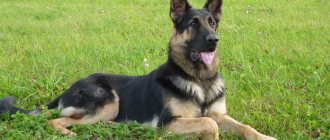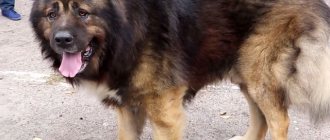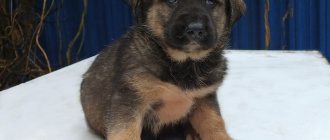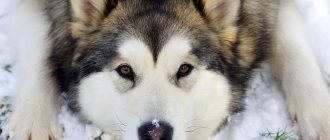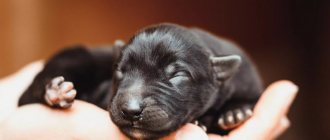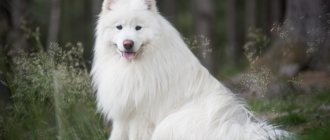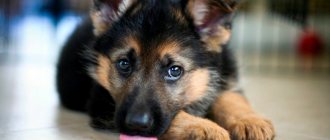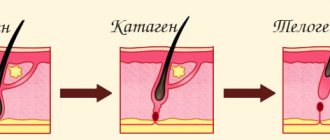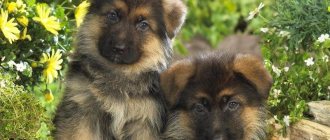German Shepherds have beautiful thick hair, which requires regular and conscientious grooming. First of all, this concerns the correct selection of a complete diet and various hygiene procedures. The owner of such a dog needs to know exactly what and when to do to provide the pet’s coat with proper care.
At what age and how often should you bathe your dog?
German Shepherds often tolerate water procedures calmly and love to swim if they have been accustomed to this from an early age.
Bathing a German Shepherd puppy should not begin until it reaches the age of three months. During this time, the pet’s body will become strong enough to endure water treatments without health consequences. Up to 3 months, wiping the baby’s fur with a damp cloth or cloth is sufficient.
In the future, an adult kept in an apartment must be bathed using special products two to four times a year: in autumn, spring and summer. In winter, wool is sometimes cleaned outdoors with snow. Water procedures carried out in winter can provoke illness in a dog. If there is an urgent need to bathe your pet during this period, it is necessary to thoroughly prepare and heat the room allocated for bathing.
Important! If your dog gets dirty while walking, wash him in the shower or use a damp towel to dry his fur.
In the summer, if your pet is clearly inclined to water procedures, you can shower him after walks.
When keeping a shepherd dog in an apartment, it should be washed during the following periods:
- after molting;
- 7 days before the treatment procedure against parasites (ticks, fleas and others);
- before the exhibition.
When keeping a pet in an enclosure, bathing is done no more than 3 times a year. With more frequent bathing, the protective layer of fat is washed off from the dog's coat, which can lead to colds.
It is not advisable to wash small puppies a few days before vaccination and during quarantine after it, which lasts 14 days. The first vaccinations are given quite early, at the age of 6 weeks or 2 months. It is too early to bathe a puppy at 1 or 2 months. After vaccinations, the baby’s body is weakened, and bathing can cause complications.
Water treatments – are they really necessary?
Have you often noticed mongrels occupying bodies of water? It’s true, you won’t see a sight like this. In their natural environment, dogs never “take a bath.” At the same time, outright dirty people are also rarely encountered. The coat of smooth- and wire-haired dogs is adapted for self-cleaning.
Another thing is purebred pets, which are distinguished by fur that is far from natural. Long-haired dogs, especially those whose hair is most similar to human hair, need water treatments relatively often. Regular wiping of paws after a walk is not necessary in this case.
In the context of washing, dogs are divided, among other things, into adults and puppies. We will discuss the frequency of bathing in the next section. But even basic logic suggests that puppies need washing much less than mature animals. About puppies and adult pets - video at the end of the article.
How to bathe at home
Before bathing your puppy for the first time, it is necessary to prepare. After all, the dog’s attitude towards subsequent baths depends on how everything goes this time. Try to communicate with your baby calmly and affectionately, and do not frighten him with sudden movements. Let him get comfortable in his new space by sniffing and examining everything in the bathroom. After this, you can start washing your German Shepherd puppy.
Your pet’s future attitude towards this procedure depends on how the bathing goes for the first time.
Keeping a German Shepherd in a private home
A German Shepherd can easily live in the courtyard of a private house and guard the territory. But being kept on a chain is detrimental to the psyche of any dog, therefore representatives of this breed should not be placed on it (a short stay on a chain is allowed, for example, if you need to bring guests into the house).
A German Shepherd needs an insulated enclosure with shelter
If the dog cannot be provided with the entire territory of the yard, a spacious enclosure with an insulated booth will be built for it, where it will hide in bad weather. Keeping it in the yard or in an enclosure does not at all replace walking; it should be carried out in full, as for pets living in an apartment.
What you need for swimming at home
Prepare in advance everything you may need for the procedure:
- To begin, provide the bottom of the bathtub with a non-slip surface—a rag or a rubber mat—to prevent your dog from slipping.
- Wear clothing suitable for this type of procedure (waterproof apron).
- Place vegetable or castor oil for your dog's eyes and cotton swabs for his ears in an easy-to-reach place. These items are necessary to minimize discomfort from soap suds or water getting into your pet's sensitive organs.
To prevent soap from getting into your puppy's ears, you can use a disposable shower cap. - Purchase dog hair shampoo from a specialty store. Do not use soap to wash your shepherd.
- Prepare a terry towel.
Important! Do not forget to take your pet for a good walk outside before bathing, otherwise after the procedure he will want to go for a walk again and may get dirty or catch a cold.
How to wash a German Shepherd puppy
Treat your puppy's first bath like bathing a newborn baby. Prepare thoroughly and plan ahead.
Stages of bathing a baby for the first time:
- Fill the bath with water so that it covers the animal's paws or reaches a maximum of the dog's chest. Make sure that the water temperature does not exceed 35-36 degrees.
- Place 1 drop of vegetable oil into your pet's eyes and insert cotton swabs into the ears.
- Place the dog in the bathtub and use the shower to wet the animal's fur everywhere except the head.
- Using special shampoo and a sponge, thoroughly soap your puppy's entire body, including his paws, belly and neck.
- Rinse off the foam with a shower, sparing no water. Repeat the procedure if necessary. You can’t leave detergent on your pet’s skin: the hair in these places sticks together, and dogs’ skin is sometimes irritated by the chemicals.
- Turn off the water, remove the swabs from the dog’s ears and treat the ears with oil.
- Wrap your baby in a towel and remove him from the bath. Try to dry the animal's fur as best you can. If the fur remains partially damp, allow the puppy to shake itself and dry off on its own by running around the house. If the puppy is not afraid of loud noises, try drying the fur with a hairdryer.
After bathing, the shepherd's coat takes about 3 hours to dry
. Try to bathe the animal within 10 minutes. Eliminate the possibility of drafts in the room so as not to provoke a cold in your pet.
Important! After washing, walks are allowed only after 3 hours.
Detergents
The process of bathing dogs also has specifics. It’s one thing to wash your paws after walking, and quite another to bathe your pet from head to toe. It doesn’t matter how old or months old the animal is, the approach to bathing is the same. Except for the frequency of the process, of course.
Washing an adult dog
A small dog and puppy can also be washed in a basin. Large ones should be “soaked” in the bath. To prevent the paws from slipping, it is better to lay a rubber mat. First, you need to thoroughly wet the wool, and then start lathering. We recommend washing not with shampoo concentrate, but with a thick foam diluted in water.
They start washing from the back, gradually moving to the stomach and paws. This applies to both an adult dog and a puppy. The wool is washed with massaging movements. Particular attention should be paid to the fur in the anal area. Don’t forget about the other “pole” - the muzzle. There is no need to be afraid of foam getting into your eyes; almost all dog shampoos are “anti-tear” shampoos. Yes, and dogs’ eyes are structured differently and react to detergents differently.
But you need to be careful about getting water into your ears and nose. It is better to plug your ears with cotton swabs. And the spray into the nose can cause your pet to choke. When the shampoo is washed off, apply conditioner. Wait a few minutes and wash it off too. If you want to fluff the wool, the water should be warm. Otherwise, use relatively cold water. Of course, if the air temperature allows, the dog should be protected from colds.
My puppy
You already know at what age you can wash a puppy. Puppies are more timid, especially if bathing is new to the dog. Therefore, you need to act very carefully. The water temperature should be about 35 degrees. It is necessary to wash with a small pressure so as not to frighten the animal even more. After water treatments, be sure to dry the dog.
- It is advisable to comb long-haired dogs well before washing to avoid the appearance of tangles;
- after bathing, the water is wrung out; when the water is squeezed out, it’s up to the pet – he shakes himself off on his own; after this, the animal must be wrapped in a towel for a while so as not to risk the dog’s health;
- again, long-haired dogs need to be dried additionally with a hairdryer - the hair takes a long time to dry, and eczema can occur due to wet hair; in parallel they “work” with a comb;
- The ears are wiped with cotton pads.
Even if the dog is washed often and it is already used to it, not only its paws are dirty, the reaction to post-bathing may remain unchanged. After washing, the animal often runs around the house. This is normal, this is how four-legged pets warm themselves. No matter how long or how old you teach a dog, only a few people like to wash themselves. You need to look not at the reaction, but at the physiology of the animal and practical experience.
How to wash a shepherd outside
In the heat of summer, you can bathe your German Shepherd puppy in an open pond every day, starting at the age of 4 months. Such procedures will help strengthen the dog’s muscles and perfectly stimulate its physical development.
If you took your pet to a river or lake, before swimming, pay attention to the condition of the reservoir and the shore. Are sharp objects, glass shards or other foodborne debris visible? This precaution will help avoid unwanted injuries and poisoning of the animal.
After inspection, let your dog off the leash and let him get used to the new place. German Shepherds are not shy, but each animal has its own individual character traits.
Swimming in a pond is useful for strengthening muscles and joints BUT
How to act near a pond:
- If you see that the puppy is scared and is in no hurry to go into the water, do not try to force him or throw him there. First, go into the water and call your dog. Due to the high degree of trust in the owner, the shepherd dogs then willingly follow him.
- If the puppy does not respond to your call, try luring him into the pond with a toy or stick. Don't forget to use the "Aport!" command.
- If the weather is good, there is no need to dry your dog's coat with a towel after swimming. Let it dry naturally, play and run with it.
Important! After an illness, it is better to wait about 10 days for bathing from the moment your pet recovers.
Coat
The skin of a healthy dog is covered with a film, the functions of which are to deodorize and disinfect. This film produces lard, which lubricates the wool, which gives the fibers shine.
If the German Shepherd does not have health problems, then the clean and shiny undercoat has no odor.
To avoid any problems with the fur in the future, you can only bathe your pet completely in an emergency when the coat is very dirty. Otherwise, you risk washing off the protective film from the skin, which will lead to dandruff and dull hair.
If the shepherd lives in an apartment, it will be enough to wash its paws after a walk. Usually the dog quickly gets used to this procedure and climbs into the bath on its own or offers its paws if, after a short exit, you simply wipe them with a wet rag.
Main periods
You can start bathing your puppy completely after three months, when the baby’s body is fully strengthened. Until this point, it is better to wipe your pet with a damp cloth.
An adult German Shepherd is bathed three times a year: in spring, summer, and autumn. In winter, it is better to do without these manipulations so that the dog does not get sick. If the dog still needs to be bathed in winter, this should be done in a well-heated room.
Without water procedures
The rest of the time, you can use regular combing. This is done in order to remove dead skin plates, fallen villi, and grains of dust. Brushing is also an excellent option for skin massage.
In spring and autumn, when seasonal shedding occurs, try to brush the undercoat daily. If you live in an apartment, you can do this outside while you walk, so as not to pollute the room again.
A metal brush is perfect for brushing your dog. Prefer bristles or curved teeth - this will make the task easier for you.
If your pet's fur is too dusty after a walk, you can use a washcloth and wet it a little. After this process, be sure to dry your German Shepherd's coat with a dry towel. And only then comb the undercoat.
Education and training
Conventionally, the process of raising a dog consists of socialization, education and training of the animal, although these processes are closely interrelated.
Socialization must begin from a very young age to form an adequate reaction of the dog to people. When raising and training, it is not recommended to raise your voice and hit the dog, feed your pet for tricks, train the animal on a full or empty stomach, rush, or stop there.
Depending on age, the pet should be able to:
- 1 month – communicate with people, respond to a nickname, wear a muzzle, collar and leash, learn to use a tray;
- 2-3 months – perform the commands “Come to me”, “Fu”, “Place”, “Teeth”, “Voice”;
- 4-6 months - know the commands and gestures “Next”, “Sit”, “Lie down”, “Stand”, during this period the baby is introduced to stairs, a barrier and boom;
- 6-8 months – overcome obstacles, alternate commands, perform new commands “Fetch”, “Give”, “Barrier”, “Forward”;
- 15 months – the pet must pass a general training course and calmly wear ammunition;
- 1.5-2 years - a German shepherd can be trained in a protective guard service course.
German Shepherds, regardless of age, are very smart dogs and loyal to humans. With a competent approach to training, caring and feeding your pet, you can raise a responsive, sympathetic and loyal friend and protector of your family.
Washing a Yorkshire Terrier
Such puppies should be bathed even more often than poodles. Regular Yorkies are washed twice a month. Exhibition animals are even bathed once a week. The water used to wash these small dogs is warm - about 38 °C. The coat of such puppies is washed with shampoo twice, after which conditioner is applied.
Blow-drying Yorkshire Terriers after a bath is not necessary. Usually, after bathing, such dogs are simply wrapped in a towel.
Owners of such pets, of course, will also be wondering when they can bathe a puppy for the first time. Yorkies, like other dogs, are also usually bathed for the first time at 3 months.
How to wash a puppy
To protect the animal's fur from various pests, nature has awarded it with a special lubricant, which is secreted by the sebaceous glands. If you wash only with clean water without soap, the natural lubricant is not washed out. But when using soap solutions, all protection is lost. Therefore, it is necessary to choose special shampoos that are designed specifically for animal fur.
Without water procedures
In addition to bathing, dogs need daily grooming. This includes simple combing. It must be done to get rid of dust, dirt, tangled dry grass, as well as old peeling skin. During the period of seasonal molting, namely autumn and spring, there is no way to do without combing the fur. This is especially true for long-haired breeds. Large dogs, for example, a German shepherd, are best brushed outside, so as not to have to clean up the apartment with fur scattered all over the place.
In summer, in dry weather, a dusty body can be wiped with wet wipes. Or you can wet a washcloth and perform a massage, which is also beneficial for your pet’s skin. After this, wipe the fur dry with a towel. Then you can start combing. It is better to choose a metal comb with bent teeth.
What you will need
You need to stock up on these items for bath days in advance:
- For small breeds, a sink or basin is suitable. It is better to teach large breeds to take a bath straight away.
- A favorite treat to calm your dog down at the right time.
- Special shampoo for dogs, selected by age.
- Watering ladle.
- Several clean towels that you will only use to dry your dog. Afterwards, a person cannot use them, even if they are washed thoroughly.
- Brushes and combs for combing out dried wool; wet fur should not be combed.
Choosing a Shampoo
Specialized shampoos for animals are usually very different from human ones. They do not contain various flavored dyes, unknown substances that impart a strong specific odor, alkalis and other unnecessary additives. Dog detergents are made specifically for fur, not hair.
Good quality shampoos are certainly not cheap, but they last a long time, since dogs often do not wash themselves, unlike humans. Here are a few manufacturers that have proven themselves well: Hartz, Doctor Vic, 8in1, Tropiclean.
When looking for a shampoo, you need to take into account the dog's age, breed, coat type, as well as the purpose, for example, for fleas. Shampoo instructions and recommendations will help you make the right choice. Conditioners are usually purchased from the same brand and from the same line of detergent.
